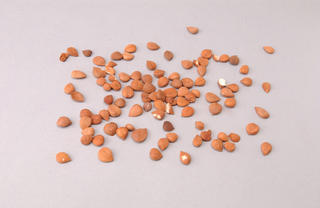Prunus sibirica
Contents
Nomenclature
Other Names:
Historical Use of Prunus sibirica
Prunus sibirica in Traditional Chinese Medicine
Background
Chinese Name (pinyin): Kuxingren
Chinese Name :
Common Name :Bitter apricot seed
Specific Name : Semen armeniacae amarum
Scientific Name:
Collection : The fruit is collected in summer and the seed is remove from the pulp and the shell and dried in the sun.
Description : Flattened cordate, 1 - 11.9cm long, 0.8 - 1.5 cm wide, 5 - 8mm thick. Externally yellowish brown to deep brown, acute at one end, plump and un-symetrical and rounded at the other end. A short linear hilum situated at the acute end and a chalaza at the rounded end with numerous upward deep brown veins. Testa thin, cotyledons 2, milky white, oily, odorless and taste bitter.
Identification : 1.Grind several grains of the drug with water, a characteristic odor of benzaldehyde is perceptible.2.Break several grains of the drug to pieces and immediately place about 0.11g into a test tube, moistened with several drops of water, hang a strip of trinitrophenol TP and stopper tightly. Heat on a warm water bath for 10 minutes, the test paper turns to a brick red color.3.To 1g, add 50ml of ether, heat under reflux for 1 hour and discard the ether solution. Wash the residue with ether, evaporate to dryness and 30ml of methanol and heat under reflux for 30 minutes. Cool to room temperature, filter and use the filtrate as the test solution. Dissolve a quantity of amygdalin CRS in methanol to produce a solution containing 2 mg per ml as the reference solution. Carry out the method for thin layer chromatography (Appendix Vl B), using silica gel G as the coating substance and the lower layer of chloroform ethyl acetate-methanol-water (15: 40: 22: 10) on standing at 5 - 10ºC for 12 hours as the mobile phase. After developing and removal of the plate, spray immediately with a solution of phosphomolybdic acid in sulfuric acid (to 2g of phosphomolybdic acid, add 20ml of water to dissolve. Add slowly 30ml of sulfuric acid and mix well). Heat at 105ºC for about 10 minutes. The spot in the chromatogram obtained with the test solution correspond in position and color to the spot in the chromatogram obtained with the reference solution.Assay: Place 15g of the coarse powder, accurately weighed in a kjeldahl flask, add 150ml of water. Stopper tightly and immediately, allow to stand for 2 hours. Connect the condenser and distill. Collect the distillate in a receiver containing 10ml of water and 2 ml of ammonia TS. Cool on an ice bath until it shows no reaction characteristic of hydrocyanic acid (to 2ml of ditillate, adjust alkaline with sodium hydroxide TS and several drops of trinitropanol TS and no red color is produced). Stop the distillation, add 2ml of potassium iodide TS to the distillate and titrate with silver nitrate (0.1 mol/L) VS slowly until a yellowish white opalescence is produced. Each ml of silver nitrate (0.1 mol/L) VS is equivalent to 91.48mg of C20 H27 NO11. It contains not less than 3.0% of amygdalin (C20 H27 NO11).
Processing : Eliminate foreign matters, break to pieces before use.Semen Armeniacae Amarum (rinse in boiling water): Peel as described under the method for rinsing in boiling water (Appendix ll D). Break to pieces before use.Stir fried: Stir fry the rinsed Semen Armeniacae Amarum as describe under the method for simple stir frying (Appendix ll D) until it becomes yellow. Break to piece before use.
Action : To relieve cough and asthma, and to relax bowels.
Indication :
Precautions :
Dosage : 4.5 to 9 g, to be added when the decoction is nearly done.
Storage : Preserve in a cool and dry place, protected from moth.
Synonymns for Prunus sibirica
Patent Medicines and Medicines with Multiple Ingredients that include Prunus sibirica
Pharmaceutical Information
Chemical Constituents
Evidence or the Use of Prunus sibirica in the Treatment of Epilepesy
Basic Science
Animal Studies
Cohort, Case-Control and Non-Randomized Trials
Randomized Controlled Trials
Meta-Analysis
1st Five Results: pubmed search
Qing Chen, Jia-Xiao Wang, Yi-Fan Wang, Yang Wang, Yan Wang
[Plant community differentiation of desertification region in northwest Liaoning Province, China]. [辽西北荒漠化区植物群落分异.]
Ying Yong Sheng Tai Xue Bao: 2024, 35(1);41-48
[PubMed:38511438]
[WorldCat.org]
[DOI]
(P p)
Nan Zhang, Zhirong Zhang, Chao Liu, Zeqin Xiong, Yaoyun Wei, Dehuai Meng, Meiling Zhan, Zongzhi Li, Yao Zhao, Liwei Teng, Zhensheng Liu
##Title##
Animals (Basel): 2024, 14(5);
[PubMed:38473048]
[WorldCat.org]
[DOI]
(P e)
Yanqi Peng, Yingshuo Li, Yuzhen Pi, Xiqing Yue
Effects of almond (Armeniaca Sibirica L. Lam) polysaccharides on gut microbiota and anti-inflammatory effects on LPS-induced RAW264.7 cells.
Int J Biol Macromol: 2024, 263(Pt 1);130098
[PubMed:38342264]
[WorldCat.org]
[DOI]
(I p)
Ru Yi, Wenquan Bao, Dun Ao, Yu-E Bai, Lin Wang, Ta-Na Wuyun
Sequencing and Phylogenetic Analysis of the Chloroplast Genome of Three Apricot Species.
Genes (Basel): 2023, 14(10);
[PubMed:37895308]
[WorldCat.org]
[DOI]
(I e)
Quangang Liu, Jiaxing Wen, Shipeng Wang, Jianhua Chen, Yongqiang Sun, Qingbai Liu, Xi Li, Shengjun Dong
##Title##
Front Plant Sci: 2023, 14;1267107
[PubMed:37799546]
[WorldCat.org]
[DOI]
(P e)
